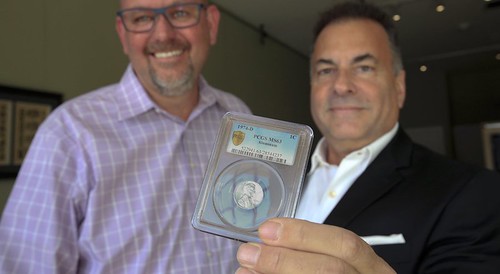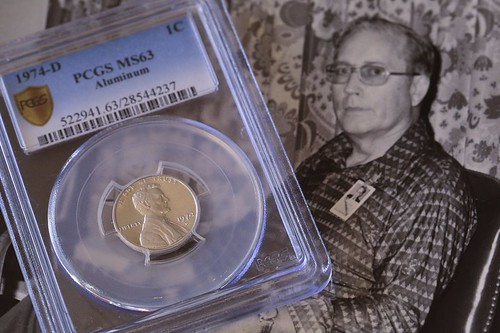
PREV ARTICLE
NEXT ARTICLE
FULL ISSUE
PREV FULL ISSUE
U.S. MINT REGAINS DISPUTED 1974-D ALUMINUM CENT
The U.S. Mint issued a press release on Thursday, March 17, 2016 stating that the lawsuit over a 1974-D aluminum cent discussed
extensively in earlier E-Sylum articles has been settled, with the Mint taking possession of the coin. Here's the press
release. -Editor

The United States Mint announced today that it has recovered a 1974-D aluminum experimental one-cent specimen that was neither authorized to be struck nor authorized to leave the Mint. The Mint’s recovery follows an agreement to resolve a lawsuit over the ownership of the piece. The lawsuit in question involved an aluminum one-cent specimen that had once been in the apparent possession of a former assistant superintendent at the United States Mint in Denver, Co. The two plaintiffs, an heir of the former assistant superintendent and a California coin dealer, filed suit in federal District Court in San Diego, Ca., seeking a declaratory judgment that the piece was legal to own. Over 1.4 million of the experimental pieces were struck at the Mint in Philadelphia in 1974 as part of a test program to possibly replace copper one-cent coins. However, Congress never enacted legislation authorizing the Mint to issue one-cent coins composed of aluminum, and the test pieces were to all be melted. The specimen piece in question bears a “D” mark, signifying production in Denver, along with the date “1974,” and appears to have been struck with a die intended for the Mint’s Denver facility. However, authority was never granted for production of the experimental test pieces at Denver. An heir of the now-deceased former assistant superintendent contended that his father was given the aluminum one-cent specimen as a gift upon his retirement. The heir provided the piece to an auction firm and hoped to sell it. In February 2014, the United States Mint became aware of plans to offer this particular piece for auction, and immediately reached out to the plaintiffs, notifying both that the United States Mint never issued, nor otherwise transferred title to any aluminum one-cent piece, and that indeed, lawful authority to issue them was never granted. Congress never divested the government's interest in the subject aluminum one-cent piece, and accordingly, it remained the rightful property of the Federal government. The Mint, upon authorization of the Secretary of the Treasury and as delegated by Congress, has the exclusive authority to mint and issue U.S. coins and other numismatic items. Items made at United States Mint facilities but not lawfully issued—or otherwise lawfully disposed of—remain government property and are not souvenirs that Mint officials can remove and pass down to their heirs. The agreement directs that title to the piece rests with the United States Mint and that it be transferred to its custody and control. Mint Police have secured the piece. The Mint considers the specimen to be a valuable historic heritage asset. Accordingly, it intends to display the specimen publicly so that this heritage asset can be properly showcased and enjoyed by numismatists, coin collectors and the general public. The display forum has not yet been decided, but the Mint will make an announcement when a decision has been made. “The Mint is very pleased with the agreement, and we are very grateful to the U.S. Attorney’s Office in San Diego for its work and efforts in reaching this resolution. We look forward to displaying the coin appropriately as an important Mint heritage asset,” said Rhett Jeppson, United States Mint Principal Deputy Director. “This agreement is not only good for the integrity of the coin collecting hobby but for the integrity of the government property and rule of law.”
The press release sidesteps the issue of exactly how the two sides came to an agreement. The suit was resolved by the agreement, not a
judgement, and the coin was not seized by the Mint police - it was 'secured". In exchange for what? There's a lot left
unsaid here and I'm left scratching my head. It will be interesting to see if the coin goes on display somehow or gets transferred at
some point into the National Numismatic Collection at the Smithsonian.
Dick Johnson forwarded this story about the finder of the cent in The San Diego Union-Tribune. Thanks! -Editor 
Michael McConnell and Randy Lawrence Real estate agent Randy Lawrence, who had unknowingly kept the treasure in a sandwich baggie for decades, and La Jolla Coin Shop owner Michael McConnell had planned to auction the coin for at least $250,000 and had fought off the U.S. Mint’s efforts to seize the penny. But a key deposition a few months ago, indicating the penny was never part of an authorized pressing and might have been struck as a practical joke at the Denver Mint, made them change their minds. “It belongs back in their hands,” Lawrence said, hours before the handoff. But all is not lost, as Lawrence and McConnell see it. Through the legal fight, the origins of the penny have emerged. “We’ve added to the history, the legacy, of this coin,” McConnell said. “At least we know more about this story.” Lawrence’s father, Harry, was deputy superintendent of the Denver Mint. Lawrence claims that as part of his retirement gift, his father was given a 1974-D aluminum penny, the “D” signaling it was pressed in Denver. But there was no official record of authorization to strike such pennies there. In his deposition, Alan Goldman, former interim Mint director who headed the aluminum cent project at the time, speculated that the Denver penny might have been made as part of a practical joke, and even has a suspect in mind. That person, whose name has not been released, is now deceased, as is Lawrence’s father, and the complete story of the penny may have gone with them. “I knew Harry Lawrence very well and he was a straight shooter,” Goldman said in his deposition. “He would not have engineered this.” In any event, Lawrence’s father apparently thought the penny was worth more in sentimental value than dollar value and never told his family about it. For decades after his father’s 1980 death, the coin sat in a baggie in Lawrence’s desk drawer along with other out-of-state coins. When he moved his family from the Denver area to San Diego in late 2013, he was introducing himself as a real estate agent to La Jolla businesses along Girard Avenue when he stepped into the La Jolla Coin Shop. A while later he brought in his father’s coin collection, which he’d been hauling around in the trunk of his car, ready to part with the inheritance. At first glance, McConnell thought the aluminum penny was made by a foreign mint, and valued it at $300. But then he began to suspect it was what it was. He paid $2,000 to have it authenticated and certified, then contacted Lawrence with the surprising news of its rarity. The pair said they could have tried to sell the coin privately and quietly, and it may have gone for a couple million dollars. In 2014, the Mint claimed its right to the coin, arguing it was clandestinely struck and federal government property that was unlawfully removed. The men responded by suing the government. On Thursday, the case was resolved when the men delivered the coin to the U.S. Attorney’s Office in downtown San Diego. Assistant U.S. Attorney Joseph Price said authorities have never found any evidence that the penny was given as a retirement gift to Harry Lawrence. “There are no free samples working at the Mint. (It) doesn’t entitle someone to take government property or pass it down to their heirs,” Price said. What happens to the penny now, and whether it will end up in Denver, Washington, D.C., or elsewhere, remains to be determined. “We look forward to displaying the coin appropriately as an important Mint heritage asset,” Rhett Jeppson, U.S. Mint principal deputy director, said in a statement. “This agreement is not only good for the integrity of the coin-collecting hobby but for the integrity of the government property and rule of law.” 
Harry Lawrence
This article sheds no light on the details of the settlement either. Great coin, though. Hopefully it will make its way to a major U.S.
coin show where it can be viewed by many people. -Editor
To read the complete article, see:
To read the earlier E-Sylum articles, see:

Wayne Homren, Editor The Numismatic Bibliomania Society is a non-profit organization promoting numismatic literature. See our web site at coinbooks.org. To submit items for publication in The E-Sylum, write to the Editor at this address: whomren@gmail.com To subscribe go to: https://my.binhost.com/lists/listinfo/esylum All Rights Reserved. NBS Home Page Contact the NBS webmaster 
|